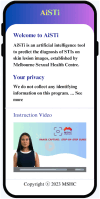Sexual health service users' perspectives on artificial intelligence applications for identification of lesions associated with sexually transmissible infections: A qualitative study
- PMID: 40727618
- PMCID: PMC12301645
- DOI: 10.1177/20552076251361749
Sexual health service users' perspectives on artificial intelligence applications for identification of lesions associated with sexually transmissible infections: A qualitative study
Abstract
Background: Early identification of sexually transmissible infections (STIs) is central to their control by facilitating timely access to healthcare. A web-based sexual health application using artificial intelligence (AI) to identify the risk of a genital or anal lesion being an STI, from a photographic image, is in development. However, the usefulness, accessibility, and acceptability of this technology to potential users are unknown. Method: This research adopted a developmental evaluation approach to explore potential users' views of the usefulness of this AI application, as well as factors impacting its acceptability and accessibility. Three focus groups were conducted with attendees of a sexual health clinic. Focus group discussions were recorded, transcribed, and analysed using action coding to identify key concepts. Results: A diverse group of 12 participants provided feedback on the proposed application. Feedback on the application's usefulness highlighted its potential value in supporting access to individualised sexual health information; informing decisions about healthcare seeking; and preventing transmission to others. Factors mediating the accessibility and acceptability of AI-powered applications included potential users' awareness of the application; concerns about data security; the accessibility of the application to diverse user groups; trust in the technology; and transparency about the application's limitations. Conclusion: AI applications for the identification of visible changes in the ano-genital region have the potential to support access to sexual health information, healthcare seeking and the prevention of onward transmission of STIs. Codesign approaches will increase the likelihood of more widespread uptake and public health impact of AI-powered sexual health applications.
Keywords: Sexually transmitted diseases; artificial intelligence; computer-assisted; health information seeking; image interpretation; mobile applications.
© The Author(s) 2025.
Figures





Similar articles
-
Population-based interventions for reducing sexually transmitted infections, including HIV infection.Cochrane Database Syst Rev. 2004;(2):CD001220. doi: 10.1002/14651858.CD001220.pub2. Cochrane Database Syst Rev. 2004. Update in: Cochrane Database Syst Rev. 2011 Mar 16;(3):CD001220. doi: 10.1002/14651858.CD001220.pub3. PMID: 15106156 Updated.
-
Population-based biomedical sexually transmitted infection control interventions for reducing HIV infection.Cochrane Database Syst Rev. 2011 Mar 16;(3):CD001220. doi: 10.1002/14651858.CD001220.pub3. Cochrane Database Syst Rev. 2011. PMID: 21412869
-
Sexual Harassment and Prevention Training.2024 Mar 29. In: StatPearls [Internet]. Treasure Island (FL): StatPearls Publishing; 2025 Jan–. 2024 Mar 29. In: StatPearls [Internet]. Treasure Island (FL): StatPearls Publishing; 2025 Jan–. PMID: 36508513 Free Books & Documents.
-
Population-based interventions for reducing sexually transmitted infections, including HIV infection.Cochrane Database Syst Rev. 2001;(2):CD001220. doi: 10.1002/14651858.CD001220. Cochrane Database Syst Rev. 2001. Update in: Cochrane Database Syst Rev. 2004;(2):CD001220. doi: 10.1002/14651858.CD001220.pub2. PMID: 11405980 Updated.
-
Hail Lifestyle Medicine consensus position statement as a medical specialty: Middle Eastern perspective.Front Public Health. 2025 Jun 20;13:1455871. doi: 10.3389/fpubh.2025.1455871. eCollection 2025. Front Public Health. 2025. PMID: 40620567 Free PMC article.
References
-
- Fairley CK, Chow EPF, Simms I, et al. Accessible health care is critical to the effective control of sexually transmitted infections. Sex Health 2022; 19: 255–264. - PubMed
-
- World Health Organization. Global health sector strategies on, respectively, HIV, viral hepatitis and sexually transmitted infections for the period 2022-2030. Geneva, 2022.
-
- Tuddenham S, Hamill MM, Ghanem KG. Diagnosis and treatment of sexually transmitted infections: a review. JAMA 2022; 327: 161–172. - PubMed
-
- Australian Government. Ministerial Advisory Committee on Blood Borne Viruses and Sexually Transmissible Infections: Syphilis Roundtable Recommendations. 2021.
-
- Jones-Vanderleest JG. Neurosyphilis, ocular syphilis, and otosyphilis: detection and treatment. Am Fam Physician 2022; 106: 122–123. - PubMed
LinkOut - more resources
Full Text Sources

